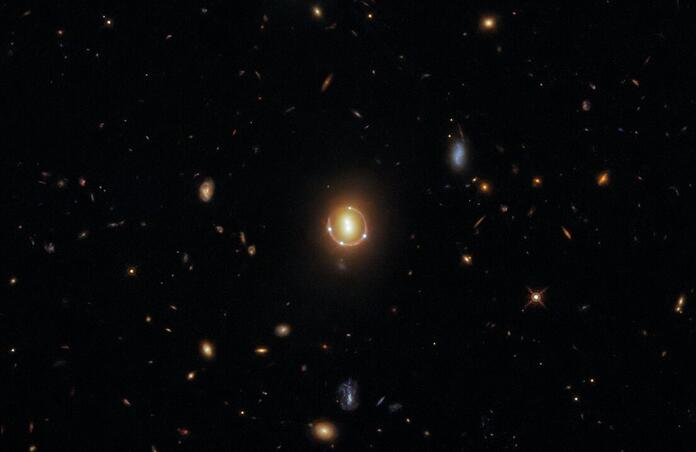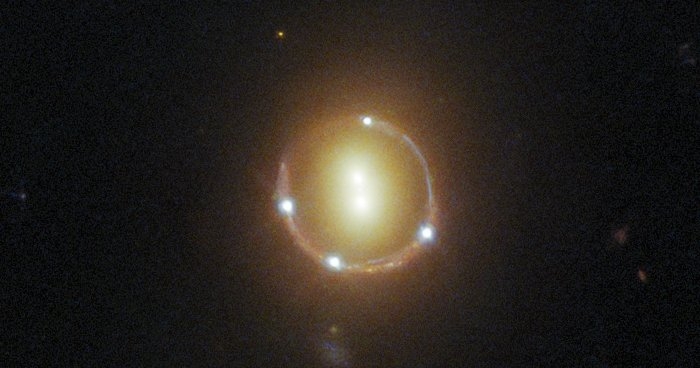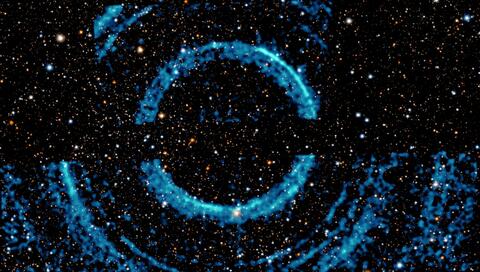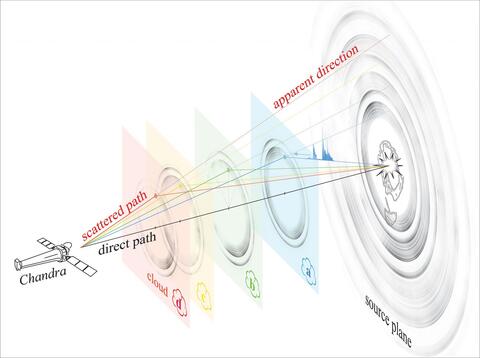The Universe's rings: lensing and light echo

Recent observations show two objects that are so well aligned with Earth that we see incredible ring shapes.
While Einstein’s theory of General Relativity is very mathematically complex, we are lucky that we find evidence in favour of it in wonderful occurrences produced by our Universe. Particularly stunning are Einstein rings, which are visual proof of the gravitational lensing effect: a galaxy, or cluster of galaxies, has sufficient mass to distort space-time (hence acting like a lens) and any light ray from a source located behind that galaxy or cluster with respect to Earth will follow that curvature. One of Hubble’s Wide Field Camera 3’s (WFC3) latest images shows an almost perfect Einstein ring, with quasar 2M1310-1714’s light being distorted by a foreground pair of galaxies.

"Zoomed in" view of the Einstein ring Diagram demonstrating gravitational lensing
In this case, there are four major “spots” along the ring; the number and intensity of those depends on the precise alignment of the lensed object, the lens and the observer, i.e., Earth. Detailed measurements can reveal the mass of the distorting object, which in the past decades has made this method the most commonly used one to map dark matter, an invisible substance required to explain galaxies’ and clusters’ masses (and one of the biggest mysteries in cosmology). As telescope technologies have advanced, microlensing is a technique that has been used to find smaller objects, like black holes or even rogue planets inside the Milky Way, according to the same principles.
Speaking of rings and black holes, an image combining Chandra X-ray Observatory and Neil Gehrels Swift Observatory data shows an incredible set of concentric rings around the V404 Cygni system – a binary system with a black hole that accretes material from a companion star just half the mass of the Sun. X-ray emissions were first observed in 2015; to be precise, it’s burst of rays as particles finally falls into the black hole that produce the rings. The flashes are so bright that the Chandra team can’t directly point the telescope’s X-ray detectors towards the target!

Composite image, with the X-ray rings and optical background of stars 
Diagram explaining the formation of the concentric set of rings: the burst encounters dust clouds where the rays get scattered
How do the bursts become rings though? The set of ring is due to a phenomenon known as light echoes, when the X-rays reflect off dust clouds between us and the V404 Cygni system. Each ring appears as the rays reach a different cloud; the closer the dust, the larger the projected ring appears. This implies that astronomers don’t just learn about the black hole’s “eating habits” (aka how much matter it consumes and at which rate), but they can at the same time estimate the distance between Earth and dust clouds, as well as their composition. The new image beautifully shows a composite image of these eight light-echoed rings on the background of stars in the optical band, taken with Pan-STARRS telescope on Hawaii.
Gravitational lensing and light echoes are two amazing effects in our Universe – thanks to the alignment of the Earth with 2M1310-1714 and a pair of galaxies, and with V404 Cygni and clouds of dust, respectively, we get to see the marvellous rings they produce.
Cover Image: Einstein ring, ESA/Hubble/NASA, T. Treu/Acknowledgment: J. Schmidt
Image Credits:
1 - Zoomed in view of Einstein ring, ESA/Hubble/NASA, T. Treu/Acknowledgment: J. Schmidt
2 - Lensing diagram, NASA, ESA & L. Calçada
3 - V404 Cygni rings, X-ray: NASA/CXC/U.Wisc-Madison/S. Heinz et al.; Optical/IR: Pan-STARRS
4 - Light echo diagram, Univ. of Wisconsin-Madison/S.Heinz
